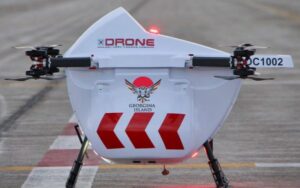
Long range drone delivery – greater than 20 kilometers or about 12 miles – is emerging as a fast growing in the autonomous delivery market, according to a new research report.
Short range autonomous delivery has gotten a lot of press recently as companies like Walmart, Amazon, Wing, and UPS engage in high profile drone delivery trials. During the current COVID crisis, contactless delivery has delivered significant benefits to vulnerable communities. Trials delivering consumer medical supplies from local retail outlets to retirement communities, or library books to local middle school students, demonstrate the benefits of short-range drone delivery.
A new research report from Markets and Markets, however, shows that autonomous delivery of longer distances may be an even more important sector. Chinese retail giant JD.com introduced contactless drone delivery in rural areas of China earlier this year: other vendors are exploring medium- to long-range drone delivery for applications such as delivery of parts and supplies along pipeline or transportation infrastructure routes. Walmart is testing several short range delivery projects along with one with drone delivery company Zipline to explore longer range routes.
This is a trend that the research report sees continuing.. “Based on range, the long range (>20 kilometers) segment of the aerial delivery drones market and the ground delivery vehicles market is projected to grow at a higher CAGR than the small range (<20 kilometers) segment from 2019 to 2030. Increasing demand for the autonomous last mile delivery of packages to long-distance destinations is fueling the growth of this segment of the market,” says a report summary.
While BVLOS flight is still generally not allowed without a waiver in the U.S., the FAA is working to create a framework that supports mid- to long-range drone delivery. Their efforts are reflected in another conclusion in the report: that North America led the market in 2019 and will continue to drive growth.
“The North American region is estimated to account for the largest share of the aerial delivery drones market in 2019. The growth of the market in this region can be attributed to increased adoption of aerial delivery drones in the food, e-commerce, and logistics & transportation industries of countries such as the US and Canada for delivering their products to customers,” says the Markets and Markets summary.

Miriam McNabb is the Editor-in-Chief of DRONELIFE and CEO of JobForDrones, a professional drone services marketplace, and a fascinated observer of the emerging drone industry and the regulatory environment for drones. Miriam has penned over 3,000 articles focused on the commercial drone space and is an international speaker and recognized figure in the industry. Miriam has a degree from the University of Chicago and over 20 years of experience in high tech sales and marketing for new technologies.
For drone industry consulting or writing, Email Miriam.
TWITTER:@spaldingbarker
Subscribe to DroneLife here.







[…] soon as thought to be the inheritor obvious to the drone supply throne, Amazon has confronted heavy competition over the past 5 years as major-league hitters like Walmart, Google’s Wing, and UPS have launched […]